Cestrum diurnum
| Cestrum diurnum | |
|---|---|
 | |
| Scientific classification | |
| Kingdom: | Plantae |
| (unranked): | Angiosperms |
| (unranked): | Eudicots |
| (unranked): | Asterids |
| Order: | Solanales |
| Family: | Solanaceae |
| Genus: | Cestrum |
| Species: | C. diurnum |
| Binomial name | |
| Cestrum diurnum L. | |
Cestrum diurnum (Din Ka Raja) is a species of Cestrum, native to the West Indies. Common names include Day-blooming Cestrum, Day-blooming Jessamine, and Day-blooming Jasmine. Also known as Din ka Raja (King of the day), in Urdu and Hindi. The scent of this quick-growing and evergreen woody shrub, often used for screens and borders, is released by day. Cestrum diurnum is easily propagated from the seed, which it produces in abundance.[1]
Description
It is an erect evergreen woody shrub numerous leafy branches. The branches, which are green and with well-marked white lenticels when young, fawn with age. The younger parts are covered with a very sparse glandular scruf.[1]
The leaves are simple, glabrous, entire, alternate, ex-stipulate, ovate-lanceolate in shape with obtuse apex and obtusely wedge-shaped below. They are dark green above and pale below and are generally 5 inches long by 1.5 inches wide. The leaves are petiolate with petioles of 0.5 inch length.[1]
The Inflorescence consists of a long axillary peduncle which bears short clusters of sweet white-smelling flowers, each cluster supported by a leaf-like bract. The individual flowers are sessile and may be with or without bracteoles.[1]
Calyx is gamo-sepalous, about 0.15 in long, somewhat puberulent, obtusely 5-ribbed and 5-lobed with obtuse, ciliate lobes.[1]
Corolla tube is narrowly infundibuliform, white, sweet-scented, about half-inch lobed with five lobes. The lobes are very obtuse and completely recurved when the flower is fully open.[1]
Stamens oblong, five in number, alternate with the corolla lobes, brown in colour, included. Filaments adnate to the tube, free for a very short distance.[1]
Ovary seated on a nectar-secreting disk. The style is filiform and glabrous. The stigmas are truncate-capitate.[1]
Cestrum diurnum has a black, nearly globular berry.[1]
Distribution
A native of the West Indies, it is widely cultivated in gardens throughout India.[1]
References
- ↑ 1.0 1.1 1.2 1.3 1.4 1.5 1.6 1.7 1.8 1.9 Bor & Raizada (1954)Some beautiful Indian Climbers and Shrubs, pp 130-131.
Footnotes
| Wikimedia Commons has media related to Cestrum diurnum. |
- Bor, N. L. & Raizada, M. B. (1954) Some beautiful Indian climbers and shrubs.(First ed). Bombay Natural History Society, Mumbai, India.